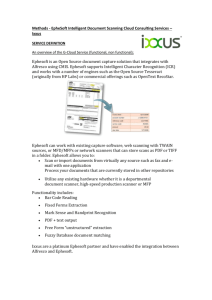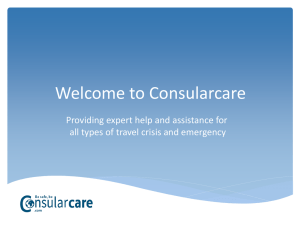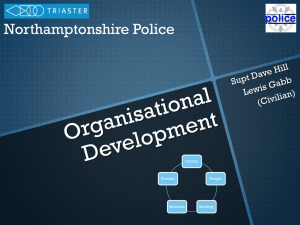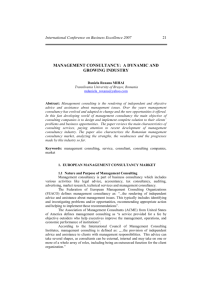Consultancy Skills
advertisement
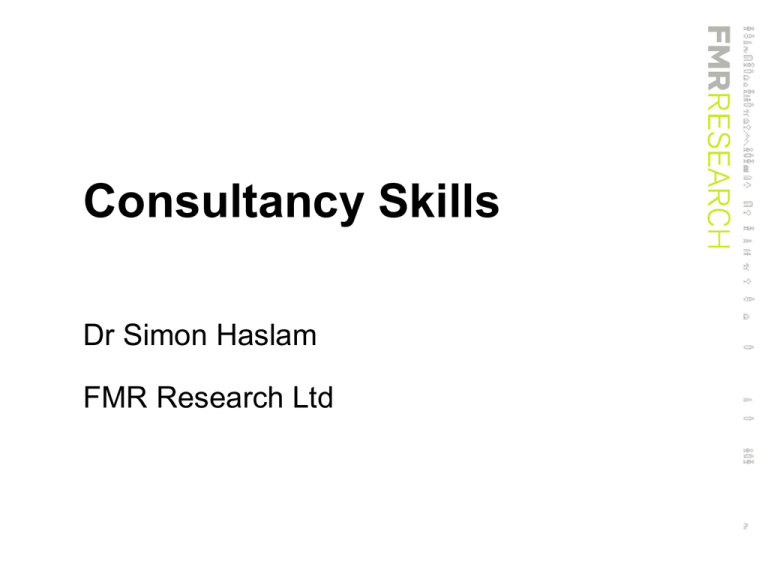
Consultancy Skills Dr Simon Haslam FMR Research Ltd Our aim To learn about consultancy in an organisational context. What consultancy involves, the key competencies and abilities, and the tools and techniques helpful to a consultant. About us • Your role • Your consultancy experience • What you’re hoping to learn from today 1. What we mean by consultancy What we mean by consultancy The MCA defines management consulting as: “The creation of value for organisations, through improved performance, achieved by providing objective advice and implementing business solutions.” “Consulting involves individuals, whether self-employed or employed, individually or collectively using their knowledge, experience and analytical and/or problem-solving skills to add value into a wide variety of organisations, and therefore to the UK economy as a whole, within a framework of appropriate and relevant professional standards, disciplines and ethics.” (IC) What we mean by consultancy “…to try to take ownership of an organisation’s problems and use research and logic to develop possible options for a way forward.” Matt Baumann “giving solutions to the problems that companies have.” Jane Ridley Consulting is about helping an organisation get from A to B… … perhaps without knowing at the outset where A is, where B is, the appetite for the journey or your role in it. Consultants = change What Feasibility - exploration Change implementation Review/evaluation Why Additional capacity, third party objectivity, process skills, access to specific information, ‘bad guy’ Eras of consultancy • Scientific management • Strategy boutiques • Technology enabled change Management Consulting Labour government - £2m pa spend Previous conservative government - £0.5m pa European market (2010) – 25m euros Sourceforconsulting.com identified six key client trends: 1. Context – the globalisation of clients will be a crucial source of growth, but at the same time, it will reshape the industry. 2. Purchase – increasing use of multinational purchasing models will impact the historic influence of relationships. 3. Resources – clients are choosing to staff more projects internally which, before they might have hired external consultants to do. 4. Delivery – instead of competition primarily being between familiar enemies, it’s now between firms and freelancers. 5. Outcome – the majority of firms now sit in the middle between advice and implementation. A new basis of differentiation is needed: outcomes. 6. Margin – fee rates among multinational companies have dropped by 10-15 per cent. Key Stages in Consulting 1. Opportunity development 2. Agreeing Terms of Reference 3. Information gathering 4. Interpretation and insight development 5. Sign-off 6. Aftercare ‘What are the deliverables?’ Cost Spec/quality Time Intervention styles • ‘Expert consultant’ • ‘Process consultant’ Hands on – hands off 7. Help them think through their own ideas 6. Add options to their ideas 5. Advise them what to do 4. Tell them what to do 3. Show them how to do it 2. Do it with them 1. Do it for them Competence framework © Institute of Consulting 1.0 Client Focus 2.0 Building and Sustaining Relationships 3.0 Applying Expertise and Knowledge 4.0 Achieving Sustainable Results 5.0 Market Capability and Knowledge 2. Perspectives helpful to consultants The organisational context Internal Micro environment Macro environment In one application, sensemaking is approached as the ability or attempt to make sense of an ambiguous situation. More exactly, sensemaking is the process of creating situational awareness and understanding in situations of high complexity or uncertainty in order to make decisions. It is "a motivated, continuous effort to understand connections (which can be among people, places, and events) in order to anticipate their trajectories and act effectively“ (Klein, as referenced in Wikipedia) • Vision – ambition, aspiration • Mission – purpose, raison d'être • Values – strategic drivers, codes ‘Hilltops’ low ‘agreement’ high high ‘certainty’ low ‘edge of chaos’ low ‘agreement’ high Zone of Extra-Ordinary Management: Under relatively ambiguous conditions - higher levels of awareness and interpersonal skill become critical Zone of Ordinary Management: - may be adequate under relatively unambiguous conditions high ‘certainty’ low Cultural web “Culture eats strategy for breakfast” Peter Drucker Kubler-Ross model 3. Analytical frameworks and tools Process guidance Start with the client – deliverables, process, perspective Pull together secondary data asap Primary data follows Facilitate external perspective/bring something new Share understanding during process Keep eyes on ‘triangle’… and keep in touch Process guidance (2) Make your client look good Expect to over deliver Invoice promptly Seek formal feedback quickly Note, but take a light touch with, follow-up opportunities McKinsey 7S Helpful when looking at organisational alignment SWOT analysis Strengths Opportunities Weaknesses Threats Helpful to summarise a situation analysis How to Change - Stages Change models Unfreezing Refreezing Changing How to Change - Stages Gerry Egan’s ‘Model B’ 1. Present ‘Blind Spots’ 2. Preferred 3. Getting there Agenda ‘Story’ Best fit Possibilities Commitment Strategies Plan ‘Leverage’ Actions leading to positive outcomes Stakeholder mapping (Mitchell, Agle and Wood 1994) Low interest High interest High power Low power Helpful when shaping perception research and change Strategy canvas 10 8 6 PS3 4 X-Box 360 2 ed ity ss or s pe ct iv Pr oc e C on ne D VD 1 D ol by 5. c di s H ar d Pr i ce 0 Helpful when looking at business models and positioning Four Actions framework Re-shaping the value curve results from the consideration of four actions ‘Raise’ means increasing the strength of a existing factor ‘Reduce’ means reducing the prominence of an existing factor (cost saving) ‘Create’ means introducing a new factor to your recipe. ‘Eliminate’ means making a factor in your current recipe redundant (cost saving) by 1 c 5. di s DV Co D nn Pr ec oc t iv es ity s or M ot sp io ee n d co nt ro la bl La e rg e pu bl ic Do l Ha rd Pr ic e Nintendo’s ‘blue ocean’ response Strategy canvas 10 8 6 PS3 4 2 0 X-Box 360 Wii 2007 Gp1-2012 Gp2-2012 Capacity building/facilitation Regional presence Product range (customers) Focus on disadvantage FT focus Political' activity Financial 'safety' Relative cost base Product range (investors) Investor diversity Share capital Perceived integrity Gap analysis (using strategy canvas) Core competence C.K Prahalad and Gary Hamel’s view is that strategy should focus on an organisation recognising ‘what it is fundamentally good at’, and building from this. They provide access to a wide variety of markets, contribute significantly to end product benefits and are difficult for competitors to imitate. Helpful when looking at internal ability Value Chain Helpful when looking at internal capability, development and out-sourcing possibilities PESTEL macro environmental forces POLITICAL SOCIAL ENVIRONMENT ECONOMIC TECHNOLOGY REGULATORY/ LEGAL Helpful as a basis for organisational design (fit for environment), horizon scanning, scenario planning, Porter’s Five Forces • Rivalry amongst those in the industry • Bargaining power of suppliers • Bargaining power of buyers • Threat of new entrants • Threat of substitute products or services • Bargaining power of buyers Helpful when looking at competitive positioning, segmentation approaches, customer needs and perception Decision making - options Suitability – does it achieve what we want? Feasibility – have we the resources/ capability? Acceptability – can we live with the consequences of this action? Creativity approaches 1. Have a process 2. Start with divergent thinking 3. Finish with convergent thinking Helpful for fresh perspectives and buy-in Metrics What get measured gets done… …what gets rewarded gets done better. Perverse outcomes… can we live with the consequence of our choice of CSF/KPI/objective Balanced Scorecard (MI) Strategy Perspective Goals Measures Shareholder satisfaction ROC, EVA, Cash, Sales growth, Cost reduction Customer Customer satisfaction Retention Development Acquisition Internal High quality people & processes Cycle time, Quality, Cash conversion, Service levels Learning & growth NPD, Employee development, Adaptability Financial Future Helpful when assessing performance, agreeing targets, MBO Risk analysis High Likelihood Med Low Low Med Impact High Helpful when evaluating change options and strategies Force field analysis Promoting forces Restricting forces Helpful when planning pragmatic change Ansoff matrix Existing products New products Existing markets Penetration Product development New markets Market development Diversification Helpful as a basis to discuss strategic options Directional Policy Matrix Industry attractiveness High Medium Low Strong Business competitive position Medium Weak Helpful when analysing portfolios and developing strategy 4. Our personal contribution TGROW - discussion road map • • • • • Topic Goals Reality Opportunities Wrap-up In a meeting/discussion – what phrases might one use around each of these five stages? Expansive Recognition Affiliation (Expressive) (Amiable) Dominant Unassuming (assertive) Achievement Security (Driver) (Analyser) Contained (emotionally controlled) How each style makes decisions PROMOTING FACILITATING • Boldly • Facilitating • Prefers new alternatives • Reluctantly • Involves others • Prefers to be part of a group decision • Quickly • Involves others • Idealistically in terms of people • Concerned about decision’s effect on other people CONTROLLING ANALYTICAL • Realistically • Reluctantly • Willing to take calculated risk • Logically • Independently • Prefers effective alternatives • Slowly • Likes to study alternative possibilities in detail • Carefully In bid meetings… Do your homework – think of the questions you might be asked Work in your elevator pitch Don’t make statements you can’t back up Ask questions back – seek to clarify Be honest – if you don’t know something, admit it Take responsibility – show how you will add value Agree follow up actions – and do yours The ‘elevator pitch’ The ‘elevator pitch’ is a short summary which quickly and simply explains a product/organisation and, importantly, its value proposition. Your elevator pitch • Addresses a problem • Outlines your solution/value proposition (what you do to help others). • Brief • Easy to understand • Emotional hooks • Say what you want Brand “A relationship with the customer” “A promise” “essence – identity – experience” Repetition builds reputation 58 Competitive Advantage D i f f i c u l t y Patents Copyright Brand Values Registered Design/logo Strategic Distribution Channels People, team, knowledge Positioning Tactical Product quality Pricing Customer Service Promotions Time taken to copy Branding and the entrepreneur • Brand often linked with entrepreneur • Brands are built – you don’t start with a strong brand • Brand development is a consequence of doing business • Does the brand have ‘stretch’? • Can you protect your brand? 10 entrepreneurial branding tips 1. The design of your logo really doesn’t matter. 1. Have a professional website. 2. Blogs are good. 3. Blogs are good, but they’re just one tool. 4. Prepare a one page corporate overview. 5. Participate in local business events. 6. Do what you say you’re going to do. 7. Stand for something. 8. Realize that you’re not in total control of your brand. 9. Branding is as much about your people as anything else. Entrepreneurial Marketing • Opportunistic – make the most of an opportunity • Customer focussed • Proactive • Innovation focussed • Resource leveraging Executive Presence Model Stories Professional image Social skills Politically aware Inspirational presenter Courage Future orientation Self belief State management © DTC Ltd Corporate view Passion Clarity Questioning – 8 views 1. Questioning for whose benefit? 2. Open-ended to explore… 3. …closed to verify 4. ‘Why’ – raises level of (but intrusive) 5. ‘How’ – homes in on practicalities/detail 6. ‘Have you considered…’ – quegestions 7. Prefixing reduces the threat of questions 8. Checking understanding - powerful Listening (after Nancy Kline) • Pay beautiful attention to the client, don’t even think about interrupting, make sounds only occasionally to indicate understanding or encouragement, keep your eyes on your client’s eyes, don’t ask picky questions, smile occasionally, look interested, be interested and be at ease… …and don’t even think about interrupting. • Clients are capable of sorting out 70% of their own problems 5. Plus… Zones of debate Zone of ‘comfortable’ debate Zone of ‘uncomfortable’ debate Intuitive core Source: Cliff Bowman What is Strategy …is the creation of a unique and valuable position, involving a different set of activities (few needs of many customers or broad needs of a few) …requires you to make trade-offs in competing – to choose what not to do. …involves creating ‘fit’ among a company’s activities. Strategy …. is derived from the military, and studies of generalship …. a pattern or plan that integrates an organisation’s major goals, policies and action sequences into a cohesive whole James B Quinn .... is to do with the matching of the activities of the organisation to the environment in which it operates Gerry Johnson & Kevan Scholes Complexity Theory Draws on Chaos Theory (small changes) Complex Adaptive Systems (no boundary or architect) Dissipative Structures (need energy to maintain) What ‘Complicated’ – where the answer isn’t obvious Challenges How organisations assimilate information How this fits with consultancy project objectives 30%, 60%, 10% Personal change process • Denial • Anger • Bargaining • Depression • Acceptance Strategy formation? Understanding what’s going on Analysis Creativity Learning Adapting to changing conditions Doing something distinctive about it DP Matrix factors Business Unit Strength Industry Attractiveness Market share Market growth rate Brand strength Market size Production capacity Industry profitability Profit margins/income Industry rivalry Growth in market share Marco-env (PESTEL) Distribution channel access Strategic thinking 1. Systems perspective – mental model of the complete system for value creation (and implications) 2. Intent focused – to be more determined and less distractible 3. Thinking in time – past/present/future in mind at the same time 4. Hypothesis driven – creative and critical thinking 5. Intelligent opportunism – being responsive to good opportunities (changing environment) How to Change - Stages Best books • Peter Block – Flawless Consulting • Peter Block - (field book for the above) • Edgar Schein – Process Consultation Revisited • Mike Cope – 7Cs of Consulting Plus, tons of stuff on the web, ‘Business Balls’ etc
